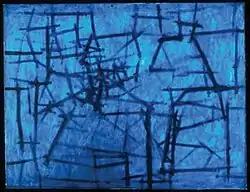Kazuo Nakamura
Kazuo Nakamura RCA was a Japanese-Canadian painter and sculptor (born Vancouver October 13, 1926; died Toronto April 9, 2002) and a founding member of the Toronto-based Painters Eleven group in the 1950s. His painting is orderly and restrained in contrast to other members of the group.[1] His idealism about science echoed the beliefs of Lawren Harris and Jock Macdonald.[2]
Kazuo Nakamura | |
|---|---|
| Born | October 13, 1926 |
| Died | April 9, 2002 (aged 75) |
| Nationality | Canadian |
| Education | Central Technical School |
| Known for | painting, sculpture |
| Movement | Painters Eleven, abstract expressionism |
| Awards | Honorary Fellow, Ontario College of Art & Design; member, Royal Canadian Academy |
Life
Kazuo Nakamura was born in Vancouver, British Columbia, and was among the Japanese-Canadians interned during World War II. He studied at Toronto's Central Technical School (1948–51), and was a founding member of Painters Eleven. Although sharing in the other members' use of painterly abstraction, Nakamura's work was distinguished within the group by his use of simpler structures and monochromatic colours.
Work

Influenced by fellow Painters Eleven member Jock Macdonald's interest in László Moholy-Nagy's reading of science, Nakamura was concerned with science, time and space. Nakamura described himself as seeking a "fundamental universal pattern in all art and nature" reflected in his "inner structure" paintings from the 1950s.[3] In the 1970s and 1980s he increasingly emphasized his grid paintings based on number structures, which came to involve the Fibonacci number system. To Nakamura, these laboriously inscribed works were a quest for some ultimate order in the apparent chaos of the universe.
Commissions
His work is part of the permanent collection at Toronto's Lester Pearson International Airport and Ontario Provincial Queen's Park Complex.
International exhibitions
In 1983 and 1984 as part of Ontario Heritage Foundation's Firestone Collection Nakamura's work toured London (UK), Paris and Madrid. In 1991 he exhibited at the New Canadian Embassy in Tokyo and in 1992 at Ader Tajan, Art Contemporain du Canada, Espace Chapon in Paris.
Honours
In 2000 Nakamura was made an honorary fellow at the Ontario College of Art & Design[4] and in 2004 he was the subject of the posthumous retrospective Kazuo Nakamura: A Human Measure at the Art Gallery of Ontario in Toronto.[5] He was made a member of the Royal Canadian Academy of Arts.[6]
References
- Nasgaard 2007, p. 115.
- Nasgaard 2007, p. 116.
- Ihor Holubizky, "Nakamura: The Method of Nature," Kazuo Nakamura: The Method of Nature, Oshawa, Ontario: Robert McLaughlin Gallery, 2001, p. 12
- "OCAD Honorary Fellows, 2000". Archived from the original on 2007-10-08. Retrieved 2007-02-11.
- Kazuo Nakamura: A Human Measure
- "Members since 1880". Royal Canadian Academy of Arts. Archived from the original on 26 May 2011. Retrieved 11 September 2013.
Bibliography
- Hill, Richard William, John Mighton, Kazuo Nakamura and Kerri Sakamoto. Kazuo Nakamura: A Human Measure. Toronto: Art Gallery of Ontario, 2004. ISBN 1-894243-42-0
- Holubizky, Ihor and Kazuo Nakamura. Kazuo Nakamura: The Method of Nature. Oshawa, Ontario: Robert McLaughlin Gallery, 2001. ISBN 0-921500-50-5
- Nowell, Iris (2011). P11, Painters Eleven: The Wild Ones of Canadian Art. Douglas & McIntyre. ISBN 9781553655909.CS1 maint: ref=harv (link)
- Nasgaard, Roald (2008). Abstract Painting in Canada. Douglas & McIntyre. pp. 115–118. ISBN 9781553653943. Retrieved 2020-08-20.